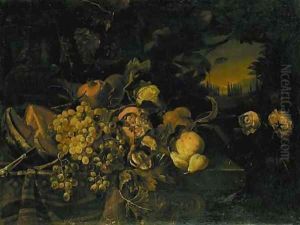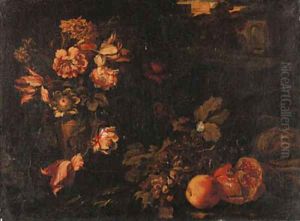Abraham Bruegel Paintings
Abraham Brueghel (also spelled Bruegel) was a Flemish Baroque painter who was born in Antwerp, the Spanish Netherlands (present-day Belgium), in 1631. He was the son of Jan Brueghel the Younger and the grandson of Jan Brueghel the Elder, both of whom were also significant painters. Abraham was part of the famous Brueghel family, which included his great-uncle Pieter Bruegel the Elder, one of the most significant artists of the Dutch and Flemish Renaissance.
Abraham initially learned the art of painting in his father's workshop, where he was exposed to the rich artistic tradition of his family lineage. Although he was born in the Flemish region, Abraham, like many artists of his time, moved to Italy to further his career, and he spent a significant portion of his life in Rome. His move to Italy had a profound influence on his work, and he became known for his still-life paintings and his lush, detailed depictions of flowers and fruit, which show the influence of the Italian tradition and the abundant light of the region.
Brueghel’s still lifes are remarkable for their vivid colors, precise detail, and the sense of texture they convey. He was also adept at incorporating elements of the Roman countryside into his works, often including small figures and animals to give life to his compositions. His works were well-received, and he became a celebrated artist in Rome, serving an international clientele that included aristocrats and members of the Catholic Church.
Abraham Brueghel's paintings contributed to the genre of still life and natural motifs, which were gaining popularity at that time. His style had a certain decorative quality that was admired by his contemporaries and has been appreciated by art collectors ever since. He spent most of his life in Italy, where he died in Naples in 1690. His legacy is preserved through his enduring artworks, which continue to be appreciated for their beauty and technical skill. Abraham Brueghel should not be confused with his ancestors, who were more focused on landscapes and peasant scenes; his contribution to art history is distinct in its focus on still life and the merging of Flemish painting techniques with the Italian Baroque sensibility.

